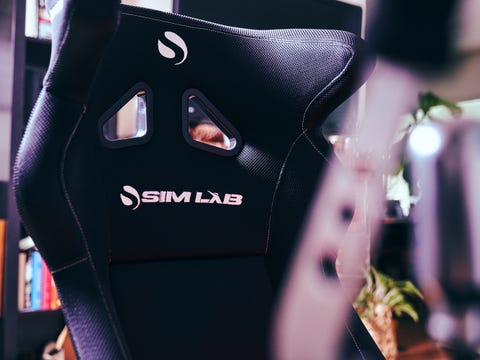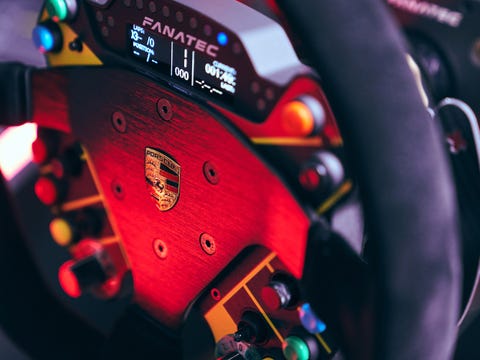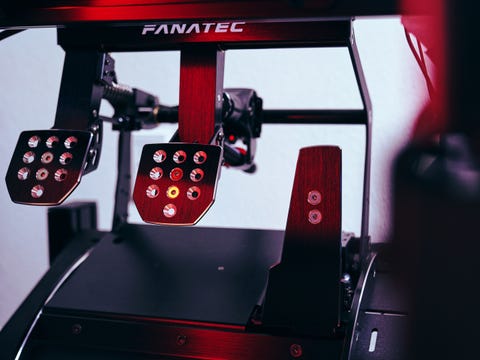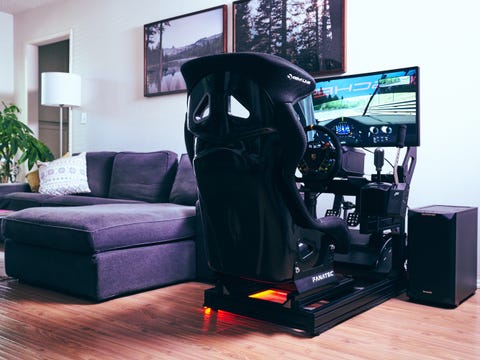Vr Car Racing
Are you obsessed with cars? Not like, Ferrari hats and Piloti loafers, but cars. Fast cars. Racing. You know, the fun stuff. And no, you don't count if you went to Cars & Coffee once and bought a t-shirt at Deus. I'm talking about the hardcore nerds. Do you know the routines of your neighbors based on their exhaust notes alone? Have you spent way too much money on car parts for your hopelessly amateur racing dreams, knowing there is no discernible reward for winning any of these events other than bragging rights within your equally nerdy crew of track buds? Are you like me? You moron. Well, months into quarantine, I found out I'm going to be a dad, so it was goodbye racetrack. But, because I'm an idiot and racing is the best, I spent $8,000 on a racing simulator in my living room instead.
When the pandemic hit and lockdown ensued, racing enthusiasts and professional drivers alike turned to virtual racing to keep the spirit of competition alive and preserve muscle memory. Sounds crazy, I know, but you'd be surprised how intense a 20-minute, wheel-to-wheel virtual race can be with a big field of drivers and open communication between the whole lot. So intense that you'll find yourself setting up fans, keeping cold water nearby, and dressing for a heatwave just to keep your shit together.
Actual pro drivers from a number of the major racing series—F1, IndyCar, and NASCAR to name a few—have been found online racing against each other and even gamers, people who might not even own a car, to feed their need for speed in the virtual world at a massively high level. (Some of those gamers are being poached to make the jump from the digital world to the real thing.) With my track car collecting dust in the garage and my fingers growing calluses from gripping my Xbox controller too tightly while playing Forza, I watched the entire racing community buying, building, and using real-deal racing simulators in their homes, and I caught a major case of FOMO. With so little to do, I caved big time, finding the absolute limits of both my loving wife's patience and our L.A. apartment's living room. Our Ikea end tables needed replacing anyway.

Alex Bernstein
I didn't want a flimsy setup with a steering wheel clamped to my CB2 desk or pedals sliding around on the floor, nor could I commit to a full-on motion rig with three massive screens and noisy motors bouncing me around, because space is tight. So I recorded super-precise measurements and looked for appropriately sized simulator rigs. One company stood out to me for its sleek design and footprint: Sim-Lab, operating out of the Netherlands. The cockpit I chose is the GT1-Evo, which isn't the biggest, baddest offering, but it's the best all-rounder without breaking the bank or taking up way too much space. It comes in many, many pieces, but as a wrencher and DIY-lover, I had fun assembling it. You surely have a similar desire to do just about fucking anything to pass the time in quarantine. I was so bored at one point that I completely dismantled my robo-vacuum (twice) just to bring it back to proper functioning, sans dog hair.

Alex Bernstein
Using a slotted aluminum structure with an array of locknuts and hardware means this setup is super customizable and insanely rigid. A full day of assembly, three bandaids, and half a crispy six-pack later, I finished off the chassis with Sim-Lab's own fixed-back bucket seat. You know, because having a full racecar spec seat is 100-percent necessary for playing video games. It's actually pleasantly comfortable, with a true motorsport sliding mechanism from Sparco. Man, if you could have been there when I unboxed it, fully making engine noises and pretending to hold a steering wheel like a kid… It was then that my wife really started to realize this was in fact the man she'd married and the future father of her child. She can't leave me now, though!

Get the Best Intel on New Tech and Gear, Every Day
esquire.com
Now, with the chassis squared away, it was time to decide how I'd steer, shift, accelerate, and initiate tire-destroying drifts. There's really only one brand that came to mind here, and that's Fanatec. With offerings from entry-level to rip-your-thumbs-off insane, Fanatec makes the most radical wheelbases, pedal sets, and shifters. For this build, since I was committed to going all-out, I went with Fanatec's Podium DD2 system.
The wheelbase is the center of the simulated racing experience. This is where all the feel comes from; the feedback, road imperfections, resistance, and connection. The DD2 is the most advanced wheelbase of its kind, using a direct drive outrunner-type motor engineered specifically for sim racing. The unbelievable amount of torque and information that comes through the wheel provides an experience closer to the real thing than I'd ever thought possible. Twenty-five newton meters of torque! You can close your Google window, I won't make you do the conversion yourself. That's 18 pounds of force. I run this wheel set to about 30 percent power, because I'm not strong enough to give it the beans. I have to preserve these wrists for diaper changing, after all. And don't worry, the DD2 comes with an emergency stop switch for when things get a little too nuts. Yes, you read that right.

Alex Bernstein
You can slap a multitude of steering wheels on the DD2 wheelbase, too. I went with the Porsche 911 GT3 R Clubsport wheel, wrapped in suede, of course, and added the endurance button module, because why not? This wheel is a replica of what comes in the real GT3 R, with each button programmable for traction control settings, brake bias, high beams, you name it. The wheel even has LED shift lights and its own OLED display that'll report back with telemetry and timing. How is this still a game? My sim rig is way more advanced than my racecar.
Next up, we've got the pedals. I wanted a three-pedal set, because driving manual is arguably way more fun and also keeps me practicing the driving I do in real life. I opted for the inverted ClubSport V3 Pedals. Inverted pedals are exactly like a real car, but with the pivot point above the brake and clutch pedals rather than below. The brake pedal is fully adjustable with a damper to control firmness and springback, and braking is probably more consistent than your own car. Plus, the pedals look so badass—certainly nicer than anything found in a new car under $100K. Just like the wheelbase, they have a vibration motor that sends signals when you're on the brakes, engaging ABS, running over kerbs, and banging off the rev limiter.

Alex Bernstein
Finishing off the driving accessories from Fanatec, I mounted the manual shifter and handbrake to the chassis with Sim-Lab's provided brackets. I've always wanted to get more comfortable going sideways in a car, and it's wild that I'm actually teaching myself how to drift properly with handbrake techniques and clutch work, all in my living room in nothing but my underwear. This wouldn't be acceptable at any track. I'm living the dream.
If the wheelbase is the heart of this racing system, the computer is the brain, and the legs, and, okay, throw in some other vital organs. It is what makes the experience seamless, vivid, and fast. So, I got in touch with iBUYPOWER and told them what I was looking for. First off, I'm a Mac guy, so PC-buying was new territory. Could you run a sim on a Mac? Sure, but you'd be dumb to try. Games are really made for the PC crowd. Besides, PCs are way more affordable to build and customize.

Alex Bernstein
For more than 20 years, iBUYPOWER has been building some of the most hardcore gaming systems. These computers are purpose built, and as someone who really only cares for purpose-built cars, I appreciate the hell out of a black box full of TRON-esque lights and circuitry. iBUYPOWER set me up with its Gaming RDY BQIIBG201. This PC boots up faster than any computer I've ever used. I actually timed it: It's 13 seconds from pressing the power button to the login screen. The system is so good that iBUYPOWER supplies these PCs to TRD (Toyota Racing Development), and if it works for the Toyota race team, it'll do the trick nestled next to my couch. (I should note that since I got my PC, iBUYPOWER has updated its iRacing systems to current generation hardware.)
When it comes to choosing a racing simulator computer, you want to make sure you've got a fast CPU to avoid bottlenecks, enough RAM to give yourself a healthy margin for background programs, and a large—and lightning fast—solid-state hard drive to speed past loading screens. Check, check, check.
So intense that you'll find yourself setting up fans, keeping cold water nearby, and dressing for a heatwave just to keep your shit together.
Massively important, though, is the graphics card. This does all the heavy-lifting to show the best possible graphics and feed video to multiple high-resolution displays or a VR headset. Thanks to the NVIDIA GeForce RTX 2070, I have yet to see a quick stutter from the machine. It even uses a fan made by a company named Be Quiet. It earned that name, since this thing cruises along at a whisper, quieter than my MacBook Pro by a longshot.
With all this firepower, I could output video to pretty much any display setup I desired, but I'm all about clean aesthetics and really don't have the space for a triple monitor, so I went with one of the best single displays on the market. Imagine sitting in your car; hands on the wheel, a wide view of your windshield and lots of peripheral information from the driver and passenger side windows. A triple-screen setup replicates this, but if a single is what you're going for, you should be looking in the ultra-wide aspect ratio category, and that's where the 35-inch ViewSonic XG350R-C 21:9 curved gaming monitor comes in. At this super-wide ratio, I can still see out of the driver's side window, and the curved display has a subtley immersive effect. With a 100Hz refresh rate, there are zero visible hiccups.

Alex Bernstein
The display mounts to the Sim-Lab chassis, and having everything attached as one unit looks killer. It also has built-in speakers that get the job done, but when running laps online against people, you need to be able to hear the car and communicate with others, so a proper headset is in order. SteelSeries's entry-level headset gear is still better than most of what you'll find out there, but its Arctis Pro Wireless is the one. It comes with its own Bluetooth base station for true lossless and ultra-low-latency audio up to 40 feet away, which means everyone will hear you if you run to the bathroom right before the race starts. Ask me how I know! There is a quick mute button on the headset, though, which I now find very useful. You'd need to invest significant coin to build a surround-sound system that rivals the high-fidelity audio from the Arctis Pro. Glad I went this route, and I'm sure others in the house are glad too, dog included.

Alex Bernstein
As if my wife didn't hate me enough for going way too far down the rabbit hole, I thought I should take the sim experience to the final level with virtual reality. If you're not an all-out gamer, you've probably not experienced something so intense that you start perspiring almost immediately, reaching your hands out to touch things that aren't there. The VIVE Cosmos Elite is new territory. After some initial setup woes, I am now sitting in the cockpit of the Porsche 911 GT3 R, seeing my hands hold the same wheel design as what I'm actually holding from Fanatec. Look left, out the window. Look right, at my opponent. Turn all the way around, out the rear window. I'm watching my feet move from gas to brake pedal as I'm feeling my feet make these same moves. It doesn't look as good as what you'll see on a decent display, but you're talking about packing a ton of resolution (1,440 by 1,770 pixels per eye) into a tiny space. The only thing you'll get caught up on is the focal point, which seems narrowly centered on your pupils. Look down, left, right, or up, and the focus softens noticeably. But in racing, you're moving your eyes and your head to look ahead through the next turn. Honestly, after the first few corners, you're just in a new world.

Alex Bernstein
So here I am, revving out the flat six to 9,000 rpm, feeling the vibration of the engine transmitted through the wheelbase, gripping my hands on the wheel as the front tires shift over track imperfections, coming down the front straight at Mugello at 168 mph. My wrists are sore, I'm craving an overly sweet but satisfying frozen margarita for some reason, and I'm trying desperately not to fuck up, because I'm in P1. The headlights of the Corvette C7.R in my rearview mirror are bouncing around as the driver from Australia closes the gap. I spot my marker on the left and jump to the brakes to slow down for turn one. The 'Vette makes a move on the inside. I hear the engine on my right, the scraping of pad material on glowing hot rotors, and the skipping of tires as they cling to the tarmac. I don't think I'm breathing anymore. I hold on with a death grip and attempt to be hyper-delicate with the throttle to avoid stuffing my front wheel into his rear quarter, and I tuck back to the inside. Thanks to this notoriously tough, uphill double-apex, I'm back on throttle soon enough to retake my position after cocky Corvette guy comes in too hot and suffers understeer, putting him on a much slower line. I scream with nervous giggles and exhale after what feels like an eternity, loosening my grip and relaxing my body as I fly straight off the track into the dirt.
I've blown it on the last lap. Ho-ly. Shit. This is like the real thing.
I tilt the VR headset up to refocus my vision on my actual surroundings and wipe the sweat off my forehead. My wife is right over my shoulder, smiling in amazement at what a nerd I am. I have no shame; this is the coolest thing I've done in months. I have an entry pass to every track in the world, in cars I'll never get to drive, all just a few steps from my kitchen. A little extreme for the living room? You might think so. Worth it? A thousand times over.
Alex Bernstein Alex Bernstein is an LA-based commercial photographer with a racecar problem.
This content is created and maintained by a third party, and imported onto this page to help users provide their email addresses. You may be able to find more information about this and similar content at piano.io
Source: https://www.esquire.com/lifestyle/cars/a34497432/best-virtual-racing-simulator-build-gear/







Tidak ada komentar:
Posting Komentar